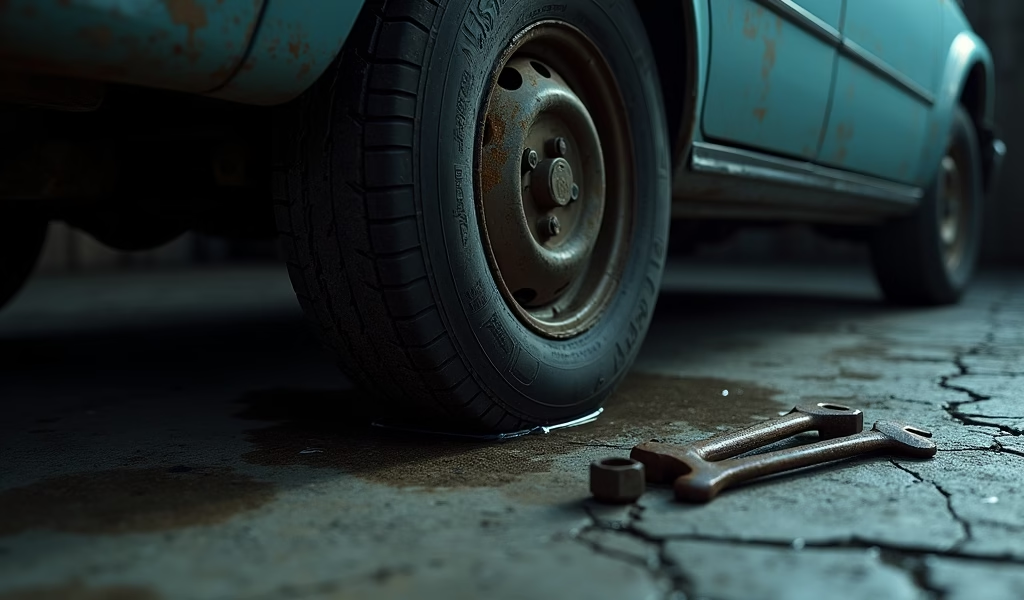Overview
This article details seven DIY car maintenance tasks that can save owners $800-1,200 annually, including replacing air filters, changing oil, installing wiper blades, maintaining batteries, replacing spark plugs, changing brake pads, and fixing minor body damage. Each repair section provides step-by-step instructions, required tools, and cost comparisons between professional service and DIY approaches, emphasizing that vehicle ownership costs can be significantly reduced through basic mechanical skills.
Table of Contents
- The Real Cost of Car Ownership (And How DIY Can Help)
- 1. Breathing New Life: Replacing Air Filters
- 2. Lifeblood Refresh: Changing Oil and Oil Filter
- 3. Clear Vision: Replacing Wiper Blades
- 4. Power Source: Battery Maintenance and Replacement
- 5. Ignition Upgrade: Spark Plug Replacement
- 6. Stopping Power: Brake Pad Replacement
- 7. Vanity Repairs: Fixing Minor Body Damage
- Your Road to Automotive Self-Reliance
- Frequently Asked Questions
The Real Cost of Car Ownership (And How DIY Can Help)
I’ve seen the look of shock on customers’ faces when I hand them repair estimates for years now. That moment when they realize their “minor issue” will cost half a month’s rent? It happens every day in repair shops across America.
The truth is, with the average repair bill now exceeding $500, your vehicle might be secretly draining your bank account. But here’s something 17 years of turning wrenches has taught me: at least half of those expensive repairs could be handled by the owner with basic tools and a little guidance.
Finding a true car bargain isn’t just about scoring a deal at the dealership – it’s about minimizing ownership costs over years. As a master technician, I’ve helped countless friends and family members save thousands with these seven DIY fixes that nearly anyone can master.
Not only will these skills put money back in your pocket, but there’s something deeply satisfying about solving your car’s problems yourself. It creates a connection with your vehicle that most modern drivers miss out on.
Ready to start saving? Let’s dive into these proven fixes that can turn your vehicle from a money pit into a genuine car bargain.
1. Breathing New Life: Replacing Air Filters
Think of your engine’s air filter as its lungs. When clogged, your car struggles to breathe properly – reducing power and fuel economy in the process.
You’d be amazed how many $80 service bills I’ve seen for a five-minute job that requires zero special tools. Here’s how to spot when it’s time for a change:
- Visual inspection shows gray or black coloring (clean filters are white/off-white)
- Your vehicle hesitates during acceleration
- You’ve noticed decreased fuel efficiency
- It’s been more than 15,000-30,000 miles since the last change
The replacement process couldn’t be simpler:
- Locate the air filter box (typically a black plastic housing with metal clips or screws)
- Open it carefully and note the orientation of your current filter
- Remove old filter and compare with replacement to confirm sizing
- Install new filter in identical position
- Secure housing closed
Total savings? While shops charge $40-60 for this service, your DIY cost is just $15-20 for the filter itself. That’s coffee money back in your pocket for a five-minute job!
Pro tip: While examining your filter, check for small animal evidence like nesting materials. In my shop, we find rodent homes in air boxes more often than you’d think, and catching this early can prevent wiring damage.

2. Lifeblood Refresh: Changing Oil and Oil Filter
I’ve rebuilt enough engines to tell you with certainty: regular oil changes are the single most important maintenance task for engine longevity. Yet shops charge a premium for this simple procedure.
Oil is quite literally your engine’s lifeblood. It reduces friction between moving parts, transfers heat, and carries away contaminants. When neglected, the resulting damage is catastrophic and expensive.
For your first DIY oil change, gather these essentials:
- Correct oil type and quantity (check your owner’s manual)
- New oil filter
- Oil filter wrench
- Oil drain pan
- Funnel
- Jack and jack stands or ramps
- Wrench for drain plug
The process is straightforward but requires attention to detail:
- Run the engine briefly to warm the oil (warm oil flows better)
- Position your drain pan under the oil drain plug
- Remove the drain plug and allow oil to drain completely (10-15 minutes)
- While oil drains, locate and remove the old oil filter (keep that drain pan handy)
- Apply a thin film of new oil to the gasket of your new filter
- Hand-tighten the new filter (follow filter instructions for proper tightening)
- Replace and tighten the drain plug to specifications
- Add new oil through the fill cap on your engine
- Check the dipstick to confirm proper level
- Run engine briefly, check for leaks, and verify oil level again
Safety reminder: Always work on a level surface, use proper jack stands, and never rely solely on a hydraulic jack to support the vehicle while you’re underneath it.
While quick-lube places advertise $29.99 oil changes, the actual out-the-door cost often exceeds $60 for conventional oil (and $90+ for full synthetic). Your DIY cost runs $25-45 depending on oil choice, meaning each oil change puts $35-50 back in your pocket. Multiply that by 3-4 changes yearly, and you’ve found a significant car bargain.
Don’t forget to recycle your used oil! Most auto parts stores and recycling centers accept it free of charge. According to the EPA, recycling just two gallons of used oil can generate enough electricity to power the average household for 24 hours.
3. Clear Vision: Replacing Wiper Blades
If you’ve ever driven through a sudden downpour with streaky wipers, you know the safety implications of this simple maintenance item. Yet dealerships regularly charge $20-40 installation fees on top of the blade cost.
When looking at used cars, I always check wiper performance – it tells me volumes about the previous owner’s maintenance habits.
Selecting the right blades matters. Check your owner’s manual for proper sizes (driver and passenger sides often differ), or use the size finder at auto parts stores. The three common types are:
- Conventional frame blades (most economical)
- Beam blades (better winter performance, longer life)
- Hybrid blades (combining benefits of both styles)
Installation takes literal seconds:
- Lift wiper arm away from windshield (it should lock in upright position)
- Locate the small tab on the underside of the wiper where it meets the arm
- Press tab and slide old blade off arm
- Slide new blade onto arm until you hear it click into place
- Gently lower arm back to windshield
Replacement costs $20-30 for premium blades that you can install yourself in under a minute. To extend their life, occasionally clean the rubber edge with rubbing alcohol to remove built-up road grime and oils.
Pro tip: Replace wiper blades every 6-12 months depending on your climate. Even if they appear functional, UV exposure gradually hardens the rubber, reducing effectiveness.
4. Power Source: Battery Maintenance and Replacement
After years at the shop, I’ve noticed a pattern – most people only think about their battery when it’s already dead. That’s a shame because proper maintenance can nearly double battery lifespan, and replacement is among the easiest DIY tasks.
Watch for these warning signs that your battery needs attention:
- Engine cranks slowly or labors to start
- Headlights dim noticeably when idling
- Battery/charging warning light appears on dashboard
- Battery case appears swollen or misshapen
- Visible corrosion on terminals (white/blue powdery substance)
- Battery is more than 4-5 years old
For basic terminal maintenance (which I recommend every 6-12 months):
- Disconnect cables (ALWAYS negative/black first, then positive/red)
- Mix baking soda and water to create a paste
- Clean terminals and cable ends with a wire brush or terminal cleaner
- Rinse with clean water and dry thoroughly
- Apply a thin layer of petroleum jelly or terminal protector
- Reconnect cables (ALWAYS positive/red first, then negative/black)
For complete replacement:
- Follow disconnection procedure above
- Remove any battery hold-down brackets or clamps
- Lift out old battery carefully (they’re surprisingly heavy)
- Clean battery tray if necessary
- Place new battery in same position
- Reinstall hold-down mechanisms
- Reconnect cables in proper order
Dealerships routinely charge $150-200 for battery replacement when the battery itself costs $80-150. The labor takes just 15 minutes. Even better? Many auto parts stores will test your battery for free, helping you avoid unnecessary replacements.
I always remind my customers: after disconnecting your battery, expect to reset radio presets and potentially deal with “relearning” behaviors from your engine computer for the first few driving cycles.
5. Ignition Upgrade: Spark Plug Replacement
Spark plugs create the controlled explosion that powers your engine. When they degrade, performance suffers dramatically. I’ve seen fuel economy improve by 10% after replacing badly worn plugs – that’s a car bargain if I’ve ever seen one.
Worn spark plugs reveal themselves through:
- Engine misfires or rough idling
- Difficulty starting
- Sluggish acceleration
- Increased fuel consumption
- Engine surging or hesitating
For this intermediate-level repair, you’ll need:
- Spark plug socket with extension
- Ratchet wrench
- Gap tool (if plugs aren’t pre-gapped)
- Anti-seize compound (for aluminum cylinder heads)
- Dielectric grease
Follow this methodical approach:
- Work with a completely cool engine to avoid burns
- Label spark plug wires/coils if removing multiple at once
- Remove one spark plug wire or ignition coil at a time
- Clean around plug base with compressed air if available
- Use spark plug socket to remove old plug
- Check gap on new plug and adjust if needed (consult vehicle specifications)
- Apply small amount of anti-seize to threads if recommended
- Thread new plug by hand initially to prevent cross-threading
- Tighten with wrench to specifications (usually 1/4 to 1/2 turn after gasket contact)
- Apply small dab of dielectric grease inside boot where it connects to plug
- Reattach wire/coil with firm push until seated
- Repeat for remaining plugs, working on one at a time
Shops charge $250-300 for this service on a four-cylinder engine, but you’ll spend just $40-60 on premium plugs. The job takes 30-60 minutes for beginners, but the performance improvement and fuel savings add up quickly.
According to research published in SAE International, properly maintained spark plugs can improve fuel efficiency by up to 4-6% compared to worn plugs.

6. Stopping Power: Brake Pad Replacement
As both a mechanic and a father, I can’t stress enough: brakes aren’t where you want to cut corners. But that doesn’t mean you need to pay shop rates for basic pad replacements.
With proper guidance, replacing brake pads is absolutely within reach of a motivated DIYer. I’ve taught this skill to dozens of car owners, and the confidence it builds is remarkable.
Replace your pads when you notice:
- Squealing or grinding noises during braking
- Brake pedal feels soft or spongy
- Vehicle pulls to one side during braking
- Increased stopping distance
- Brake warning light illuminates
- Pads visibly worn to less than 1/4 inch thickness
You’ll need these tools for the job:
- Jack and jack stands
- Lug wrench
- C-clamp or brake caliper tool
- Socket set and wrenches
- Wire or bungee cord
- Brake cleaner spray
- Anti-squeal compound or clips (usually included with quality pads)
Follow these steps carefully:
- Loosen lug nuts while vehicle is still on ground
- Jack vehicle and secure with jack stands
- Remove wheel completely
- Locate caliper bolts (usually two bolts on the back or sides)
- Remove bolts and swing caliper upward, securing with wire
- Remove old brake pads and hardware
- Clean caliper mounting bracket thoroughly with brake cleaner
- Install any new hardware included with pads
- Compress caliper piston(s) using C-clamp or caliper tool
- Apply thin layer of anti-squeal compound to backs of new pads if included
- Install new pads in bracket
- Lower caliper over pads and reinstall bolts to specification
- Replace wheel and hand-tighten lug nuts
- Lower vehicle and torque lug nuts to specification
- Pump brake pedal several times before driving to restore pressure
Always test brakes carefully in a safe area before normal driving. The process must be repeated for each wheel requiring new pads.
With shops charging $300-500 per axle for this service, your DIY investment of $75-150 for premium pads represents significant savings. Even better, quality aftermarket pads often outperform the budget options many shops install as their standard offering.
When shopping for your next car, test the brakes thoroughly – they’re among the most expensive regular maintenance items.
7. Vanity Repairs: Fixing Minor Body Damage
Body shop labor rates average $50-70 per hour, making even minor cosmetic repairs painfully expensive. But many small dings, scratches, and paint chips are surprisingly fixable at home.
After helping countless customers avoid unnecessary body shop visits, I’ve developed these go-to DIY approaches:
For paint chips and scratches:
- Clean area thoroughly with soap and water
- Use rubbing alcohol on a cloth to remove any wax or residue
- For deeper scratches, lightly sand with 2000-grit sandpaper
- Apply primer pen if bare metal is exposed (allow to dry completely)
- Apply manufacturer-matched touch-up paint in thin layers
- Use the brush tip for chips, toothpick for fine scratches
- Allow to dry completely between coats
- Apply clear coat if included with your touch-up kit
- After fully cured (usually 24+ hours), gently buff with polishing compound
For minor dents:
- Plunger method: For shallow, accessible dents on flat surfaces
- Boiling water technique: Pour over plastic bumper dents, then push out from behind
- Dry ice method: Rub dry ice over dent, causing metal to contract and potentially pop out
- Specialty dent removal kits: Particularly effective for hail damage
While body shops might quote $200-400 for minor dent repair or paint touch-up, DIY methods range from $15-50 in materials. The results won’t always be professional-grade, but they’re often surprisingly effective for improving appearance and preventing rust from developing.
According to Consumer Reports, promptly addressing paint damage not only improves aesthetics but also prevents costlier rust repairs down the road.
Remember to know your limits – significant collision damage or rust repair requires professional attention.
Your Road to Automotive Self-Reliance
After decades in the industry, I’ve watched countless car owners transform from helpless at the mercy of repair shops to confident DIYers who save thousands annually. The journey to automotive self-reliance isn’t just about finding a car bargain – it’s about taking control of your vehicle’s destiny.
By mastering these seven repairs, you’re looking at potential yearly savings of $800-1,200. That’s a family vacation or a significant boost to your savings account, all from spending a few weekend hours under the hood.
Start small with air filters or wiper blades, then gradually build confidence for tackling brake pads or spark plugs. Every successful repair adds not just to your wallet but to your mechanical knowledge base – skills that pay dividends for life.
Remember that buying a used car is just the beginning of the ownership journey. The real car bargain comes from proper maintenance that extends vehicle life while minimizing shop visits.
Your vehicle doesn’t have to be a financial burden. With these DIY skills in your arsenal, you can transform it into what it should be – reliable transportation that doesn’t drain your bank account with every minor issue.
Which repair will you tackle first? Your wallet – and your car – will thank you.
Frequently Asked Questions
What makes a car repair a good bargain?
A good car bargain repair offers significant savings compared to shop rates while requiring minimal special tools or expertise. The best examples are maintenance items with high labor charges but simple procedures, like oil changes or air filter replacements.
How much money can I save by doing my own car maintenance?
Most DIY-minded car owners save $800-1,200 annually by handling basic maintenance themselves. The savings compound when you consider how preventive maintenance helps avoid costly major repairs.
Do I need special tools for basic car repairs?
Most DIY car repairs require only basic hand tools like wrenches, screwdrivers, and pliers. Specialty tools can often be borrowed from auto parts stores through their tool loan programs.
Can DIY repairs affect my vehicle warranty?
Under the Magnuson-Moss Warranty Act, manufacturers cannot void your warranty simply because you performed maintenance yourself. Keep receipts for parts purchased and document all maintenance to protect your warranty coverage.
How do I know which car repairs are beyond DIY capability?
Avoid DIY repairs that involve safety systems, require specialized diagnostic equipment, or need precise calibration. Airbag systems, complex electronics, timing belt replacements, and transmission rebuilds are best left to professionals.

